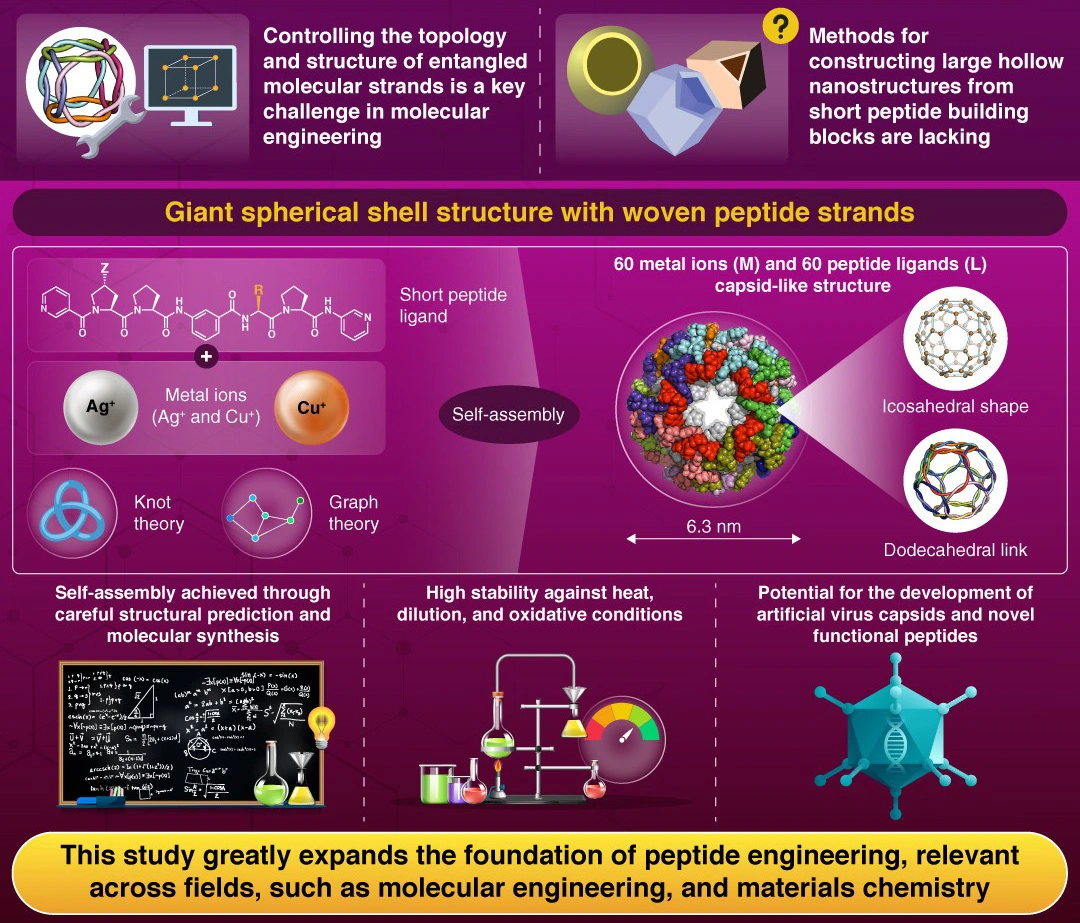Self-assembly of a large metal-peptide capsid nanostructure through geometric control
New hollow dodecahedral shell demonstrates remarkable stability and potential for functionalization and encapsulating macromolecules
A significant advancement in molecular engineering has produced a large, hollow spherical shell nanostructure through the self-assembly of peptides and metal ions, report researchers from Japan. This dodecahedral link structure, measuring 6.3 nanometers in diameter, was achieved by combining geometric principles derived from knot theory and graph theory with peptide engineering. The resulting structure demonstrates remarkable stability while featuring a large inner cavity suitable for encapsulating macromolecules, opening pathways for producing complex artificial virus capsids.
Towards Precise Geometric Control of Chemical Structures

Inomata et al. (2025) | Chem | 10.1016/j.chempr.2025.102555
Controlling the topology and structure of entangled molecular strands is a key challenge in molecular engineering, particularly when attempting to create large nanostructures that mimic biological systems. Examples found in nature, such as virus capsids and cargo proteins, demonstrate the remarkable potential of such architectures. However, methods for constructing large hollow nanostructures with precise geometric control have remained elusive—until now.
In a recent study, a research team led by Associate Professor Tomohisa Sawada from Institute of Science Tokyo, Japan, has successfully constructed a molecular spherical shell structure with the geometric topology of a regular dodecahedron. This groundbreaking work, which was published online in the journal Chem on May 01, 2025, describes how the researchers created this large structure, bearing an outer diameter of 6.3 nanometers, through the entanglement of peptides with metal ions.
“The synthesis of this highly complex structure was based on geometric considerations and predictions, leading to the proposal of a new concept: the geometric control of chemical structures,” explains Sawada. The team’s approach combined two distinct mathematical frameworks, namely knot theory and graph theory, to predict and then achieve the self-assembly of an unprecedented dodecahedral link with an entanglement of 60 crossings, composed of 60 metal ions and 60 peptide ligands (or M60L60).
The researchers had previously created smaller structures with tetrahedral and cubic links. However, a more complex dodecahedral link emerged after they introduced further modifications to the peptide sequence during attempts to functionalize M24L24, a smaller cubic link. X-ray crystallographic analysis revealed that the resulting M60L60 metal-peptide shell contains an inner cavity of approximately 4.0 nanometers (approximately 34,000 ų), which is large enough to encapsulate macromolecules such as proteins or nanomaterials.
Beyond its impressive structural complexity, the M60L60 shell exhibited remarkable stability against heat, dilution, and oxidative conditions, which the researchers attributed to its unique entangled network structure. Interestingly, the team also demonstrated that the capsid’s surface could be modified with various functional groups while maintaining its structural integrity, opening pathways for customization based on specific needs.
These features make M60L60 a promising platform for various applications, including drug delivery systems and molecular transportation. “Considering the diversity and modifiability of peptide structures, our method is overwhelmingly advantageous compared to DNA origami technology in terms of functionalizing structures,” highlights Sawada. “Moreover, since our approach involves theoretical prediction and trial-and-error experiments, sometimes astonishing structures far beyond our expectations are obtained—this is the essence of chemistry.”
Overall, this research represents a significant step forward in understanding how to construct artificial virus capsid-like structures. “Our findings significantly expand the foundation of peptide engineering and are anticipated to have immense effects across various fields, including molecular self-assembly, materials chemistry, and mathematical theories,” concludes Sawada. The researchers are now aiming for even more ambitious structures, envisioning M180L180 and M240L240 assemblies with 180 and 240 crossings, respectively, as their next challenges.
Reference
- Authors:
- Yuuki Inomata1, Sota Oguma1, Nao Sagara2, Ami Nishijima1, Yuta Saburomaru1, Satoshi Yoshida1, Takashi Kajitani3, Koya Shimokawa4, Sota Sato1,5, Michito Yoshizawa2, Makoto Fujita1,6,7,*, and Tomohisa Sawada2,8,*
- Title:
- An M60L60 metal–peptide capsid with a 60-crossing woven network
- Journal:
- Chem
- Affiliations:
- 1Department of Applied Chemistry, School of Engineering, The University of Tokyo, Japan
2Laboratory for Chemistry and Life Science, Institute of Integrated Research, Institute of Science Tokyo, Japan
3Core Facility Center, Research Infrastructure Management Center, Institute of Science Tokyo, Japan
4Department of Mathematics, Ochanomizu University, Japan
5Department of Life and Coordination-Complex Molecular Science, Institute for Molecular Science, National Institutes of Natural Sciences, Japan
6Tokyo College, UT Institutes for Advanced Study, The University of Tokyo, Japan
7Division of Advanced Molecular Science, Institute for Molecular Science, National Institutes of Natural Sciences, Japan
8JST PRESTO
Related articles
Further Information
Associate Professor Tomohisa Sawada
Laboratory for Chemistry and Life Science, Institute of Integrated Research, Institute of Science Tokyo
Contact
Public Relations Division, Institute of Science Tokyo
- Tel
- +81-3-5734-2975
- media@adm.isct.ac.jp